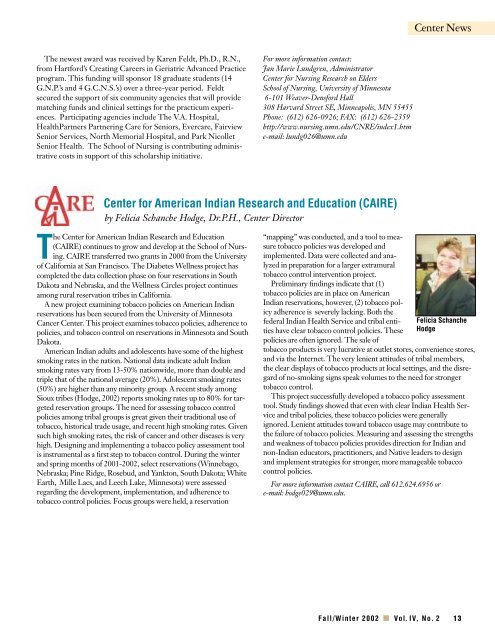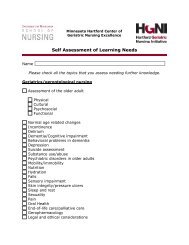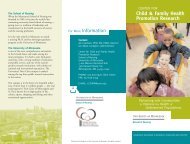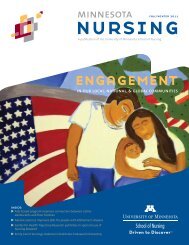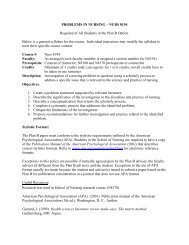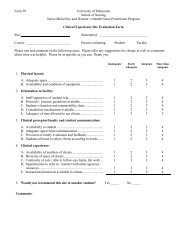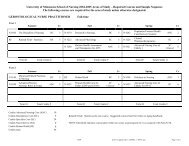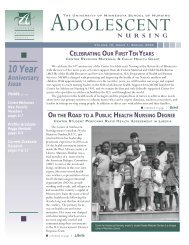Fall/Winter 2002 - School of Nursing - University of Minnesota
Fall/Winter 2002 - School of Nursing - University of Minnesota
Fall/Winter 2002 - School of Nursing - University of Minnesota
Create successful ePaper yourself
Turn your PDF publications into a flip-book with our unique Google optimized e-Paper software.
Center News<br />
The newest award was received by Karen Feldt, Ph.D., R.N.,<br />
from Hartford’s Creating Careers in Geriatric Advanced Practice<br />
program. This funding will sponsor 18 graduate students (14<br />
G.N.P.’s and 4 G.C.N.S.’s) over a three-year period. Feldt<br />
secured the support <strong>of</strong> six community agencies that will provide<br />
matching funds and clinical settings for the practicum experiences.<br />
Participating agencies include The V.A. Hospital,<br />
HealthPartners Partnering Care for Seniors, Evercare, Fairview<br />
Senior Services, North Memorial Hospital, and Park Nicollet<br />
Senior Health. The <strong>School</strong> <strong>of</strong> <strong>Nursing</strong> is contributing administrative<br />
costs in support <strong>of</strong> this scholarship initiative.<br />
For more information contact:<br />
Jan Marie Lundgren, Administrator<br />
Center for <strong>Nursing</strong> Research on Elders<br />
<strong>School</strong> <strong>of</strong> <strong>Nursing</strong>, <strong>University</strong> <strong>of</strong> <strong>Minnesota</strong><br />
6-101 Weaver-Densford Hall<br />
308 Harvard Street SE, Minneapolis, MN 55455<br />
Phone: (612) 626-0926; FAX: (612) 626-2359<br />
http://www.nursing.umn.edu/CNRE/index1.htm<br />
e-mail: lundg026@umn.edu<br />
Center for American Indian Research and Education (CAIRE)<br />
by Felicia Schanche Hodge, Dr.P.H., Center Director<br />
The Center for American Indian Research and Education<br />
(CAIRE) continues to grow and develop at the <strong>School</strong> <strong>of</strong> <strong>Nursing</strong>.<br />
CAIRE transferred two grants in 2000 from the <strong>University</strong><br />
<strong>of</strong> California at San Francisco. The Diabetes Wellness project has<br />
completed the data collection phase on four reservations in South<br />
Dakota and Nebraska, and the Wellness Circles project continues<br />
among rural reservation tribes in California.<br />
A new project examining tobacco policies on American Indian<br />
reservations has been secured from the <strong>University</strong> <strong>of</strong> <strong>Minnesota</strong><br />
Cancer Center. This project examines tobacco policies, adherence to<br />
policies, and tobacco control on reservations in <strong>Minnesota</strong> and South<br />
Dakota.<br />
American Indian adults and adolescents have some <strong>of</strong> the highest<br />
smoking rates in the nation. National data indicate adult Indian<br />
smoking rates vary from 13-50% nationwide, more than double and<br />
triple that <strong>of</strong> the national average (20%). Adolescent smoking rates<br />
(50%) are higher than any minority group. A recent study among<br />
Sioux tribes (Hodge, <strong>2002</strong>) reports smoking rates up to 80% for targeted<br />
reservation groups. The need for assessing tobacco control<br />
policies among tribal groups is great given their traditional use <strong>of</strong><br />
tobacco, historical trade usage, and recent high smoking rates. Given<br />
such high smoking rates, the risk <strong>of</strong> cancer and other diseases is very<br />
high. Designing and implementing a tobacco policy assessment tool<br />
is instrumental as a first step to tobacco control. During the winter<br />
and spring months <strong>of</strong> 2001-<strong>2002</strong>, select reservations (Winnebago,<br />
Nebraska; Pine Ridge, Rosebud, and Yankton, South Dakota; White<br />
Earth, Mille Lacs, and Leech Lake, <strong>Minnesota</strong>) were assessed<br />
regarding the development, implementation, and adherence to<br />
tobacco control policies. Focus groups were held, a reservation<br />
“mapping” was conducted, and a tool to measure<br />
tobacco policies was developed and<br />
implemented. Data were collected and analyzed<br />
in preparation for a larger extramural<br />
tobacco control intervention project.<br />
Preliminary findings indicate that (1)<br />
tobacco policies are in place on American<br />
Indian reservations, however, (2) tobacco policy<br />
adherence is severely lacking. Both the<br />
federal Indian Health Service and tribal entities<br />
have clear tobacco control policies. These<br />
policies are <strong>of</strong>ten ignored. The sale <strong>of</strong><br />
tobacco products is very lucrative at outlet stores, convenience stores,<br />
and via the Internet. The very lenient attitudes <strong>of</strong> tribal members,<br />
the clear displays <strong>of</strong> tobacco products at local settings, and the disregard<br />
<strong>of</strong> no-smoking signs speak volumes to the need for stronger<br />
tobacco control.<br />
This project successfully developed a tobacco policy assessment<br />
tool. Study findings showed that even with clear Indian Health Service<br />
and tribal policies, these tobacco policies were generally<br />
ignored. Lenient attitudes toward tobacco usage may contribute to<br />
the failure <strong>of</strong> tobacco policies. Measuring and assessing the strengths<br />
and weakness <strong>of</strong> tobacco policies provides direction for Indian and<br />
non-Indian educators, practitioners, and Native leaders to design<br />
and implement strategies for stronger, more manageable tobacco<br />
control policies.<br />
For more information contact CAIRE, call 612.624.6956 or<br />
e-mail: hodge029@umn.edu.<br />
Felicia Schanche<br />
Hodge<br />
<strong>Fall</strong>/<strong>Winter</strong> <strong>2002</strong> ■ Vol. IV, No. 2 13


